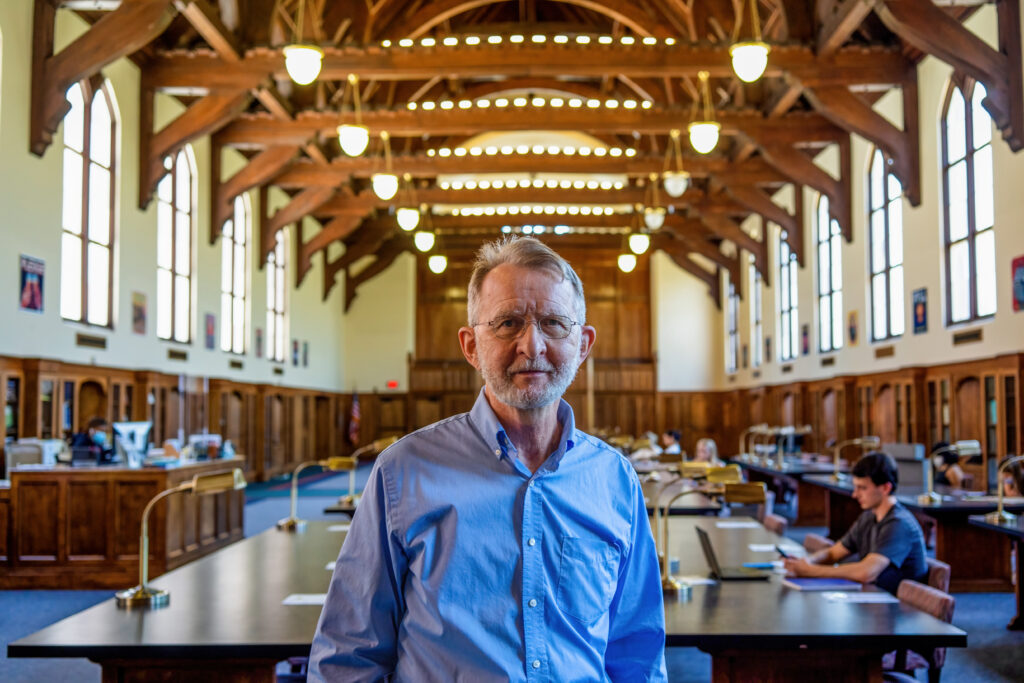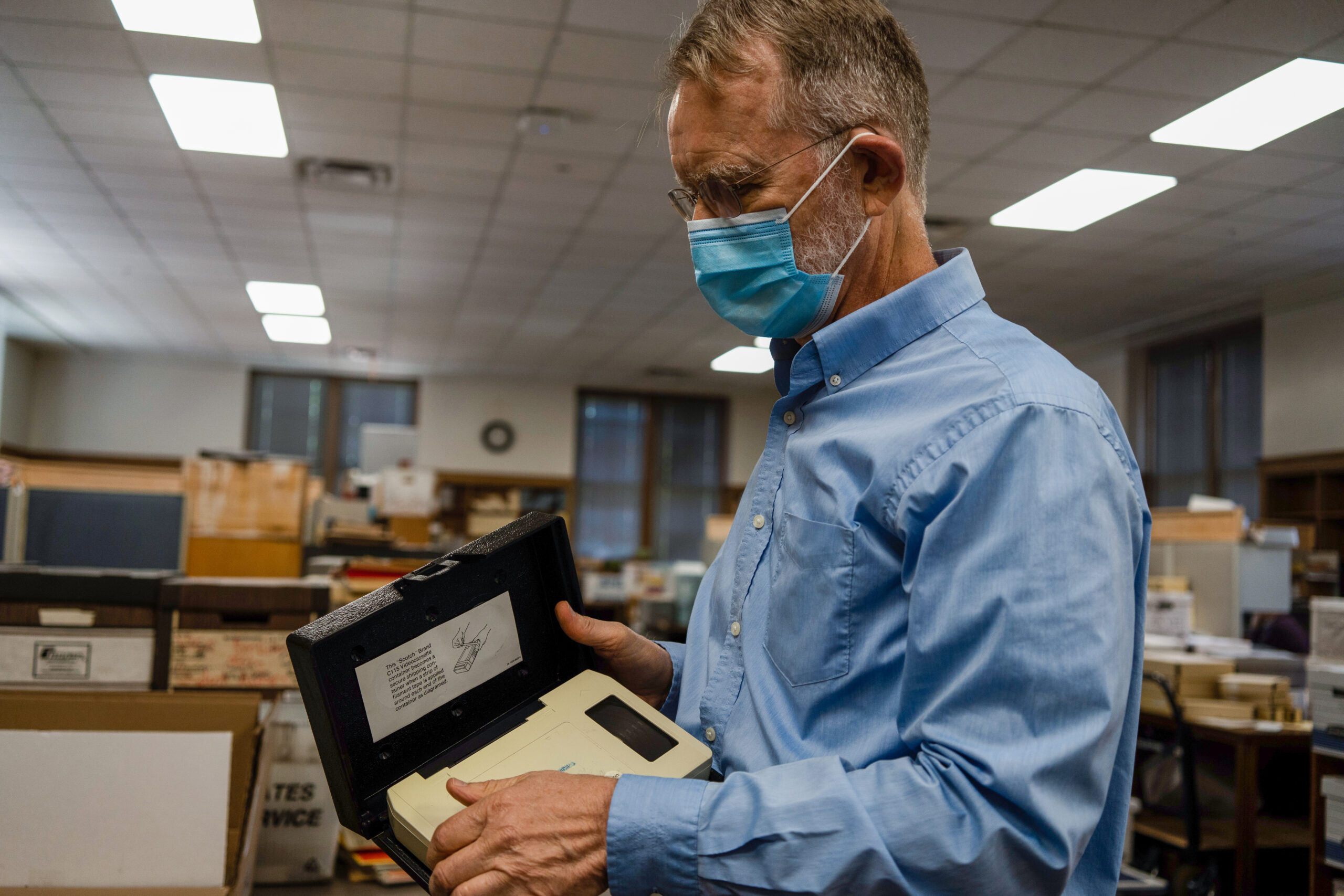UF historian bids farewell to his beloved archives

Carl Van Ness has been UF history’s caretaker for almost 40 years. But this June, it will be time for him to retire.
Story by Caitlin Petros | Photos by Anderson Bobo
Carl Van Ness can answer almost any question about the University of Florida on command. And if he can’t, he knows where to find the answer.
He’s been affectionately decreed “a walking UF encyclopedia” and the “Tom Brady of all archivists” by his colleagues. Appropriate nicknames, perhaps, for a man who has a knack for the stacks of the UF archives. He has soaked up as much history as one man could over four decades at Smathers Library, and he has the stories to prove it. Like this one:
In 1913, a UF student took a biscuit from a mess hall, put an address and stamp on it, and mailed it to Rome, Georgia. Sallie Burwell of Shorter College, for whom the biscuit was intended, returned it to the sender, Albert P. McIntosh, as a joke. McIntosh eventually returned it to the UF archives, and the biscuit now remains one of its most famous items.

This biscuit is more than 100 years old — and it’s one of the archives’ most well-known and well-loved objects.
Now with these tidbits of history plastered in his head after nearly 40 years at UF, Van Ness plans to retire at the end of June.
And he is going out with the satisfaction that the vast collections housed at the university have passed through his hands.
“It’s a sense of discovery and knowing that you are preserving something for posterity,” he says.
A pair of double doors swing open to reveal Smathers Library East. Adorned with gothic charm and anointed with the wealth of time, centuries of history reside within the library’s walls. And it’s cared for by a man who lives for the past.
On the second floor sits Van Ness’s office. Five tables swallow the spacious room, along with his desk and a wall of shelves lined with books. The office was originally intended to be a space for past state senators to use while on campus. One, Bill Nelson, who now heads NASA, donated a collection of papers and other historical material to the university. A campaign sign propped against the window pays him homage.
The office is fit for a well-seasoned archivist, with boxes of videotapes, an old phonograph in the corner and two refurbished VHS players on the way. After Van Ness leaves, a new archivist will continue the work that he’s started on audio-visual items. His recent project has been working with audio-visual items. He reclines in his office chair, pointing out different pieces of decades-old equipment that might otherwise seem unimportant to a non-history buff.


Van Ness has been working with VHS tapes and other audio-visual items to piece together parts of UF’s history.
Van Ness was born and raised in Jacksonville’s Riverside neighborhood. A lot has changed since then, he says, but he still makes regular trips home to visit his brother and 102-year-old aunt.
He credits his parents with instilling in him an interest in history from a young age. He spent his days in the library instead of chasing soccer balls, lizards or girls. In sixth grade, when it came time for students to have school “jobs,” the boys typically landed as hallway patrol, and the girls became office aids or helped at the library. But the school librarian personally asked the principal to allow Van Ness to work in the library, against the gender norms of his time.
Van Ness went on to study history at the University of South Florida and then UF to pursue a master’s degree. Or so he thought.
While working on a thesis about the Cuban railroad construction, he received an opportunity at Smathers to work with collections on the Cuban sugar industry. That stint solidified his passion for library sciences. He became so fond of the job, he joked he would do it for free.
Van Ness changed directions and transferred to Florida State University to earn his master’s in library sciences. Through an FSU extension program, he remained in Gainesville and worked within the archives. After his graduation, he began his storied career with the university.
On the first floor of Smathers, Van Ness squeezes through tight rows of floor-to-ceiling shelves, navigating a maze of archival documents and objects.
He reaches for a row stacked with items tucked away safely in acid-free boxes. UF’s archives also serve as a museum, containing artifacts and anecdotes about student life throughout the decades.
Van Ness first unveils an orange felt hat called a “rat cap.” These were worn by freshmen to differentiate their status on campus, and they date back to before World War II. The navy blue felt numbers on either side of the “F” identify the year it was worn. He opens another box filled with dance cards that date back to the 1910s. Students used these social cards to record who they danced with at an event for their own keeping. Van Ness says that women mainly used the cards, but men would sometimes use them, especially when UF was an all-male institution in the early 1900s.
Finally, his unchanging favorite item in the archive: the women’s dorm sign-out sheets. In the mid ‘50s and ‘60s, women were required to sign in and out of their dorms at night to report where they were going and who they were going with. Van Ness enjoys showing students the sign-out sheets because they spark thought-provoking conversations about gender roles, norms and generational change.

Van Ness’ favorite archive item is the women’s dorm sign-out sheets, which endured for more than a decade.
The famous biscuit is kept in the archives as well. Sarah Coates, interim university archivist at Smathers, remembers when Van Ness first told her the story of the biscuit. It is one of her favorite memories of the historian.
“Now I get to show visitors the biscuit and tell the story just as Carl did for me,” she says. “Having all of his knowledge and storytelling ability leave here is such a loss. That is a lot of history that is walking out the door.”
Van Ness’s impact spans wide. He often worked closely with Aaron Hoover, who writes speeches for UF President Kent Fuchs and says Van Ness has been his “go-to person for years.” Hoover compares Van Ness to a reporter who digs up interesting facts that make for a great speech.
“Carl has made it so much richer to open the door to the depth of history that this institution has,” Hoover says. “The love for his work and the archives shines out.”
Van Ness’s predecessor Samuel Proctor created the UF archives as part of a centennial celebration of the university, which is the only public university in the state that has records extending to the 1880s.
Coincidentally, Proctor and Van Ness both attended Robert E. Lee High School in Jacksonville, recently renamed Riverside High.
Paul Ortiz, the director of the Samuel Proctor Oral History program, says he knew Van Ness to be a steady and wise presence in his career.
“Before I was an award-winning author, I was an anonymous grad student,” Ortiz says. “Carl treated me with respect all the way.”
Now, Ortiz and Van Ness are not only colleagues, but friends and down-the-street neighbors.
“Carl, to me, is the Tom Brady of university archivists,” Ortiz says.
The history of UF twists and turns, Ortiz says, and Van Ness owns an integral part in unearthing the many mysteries of campus.
“He’s been able to explain to us where we come from,” Ortiz says.
If Van Ness could go back in time and meet a UF historical figure, he says he’d like to meet either Andrew Sledd or Albert Murphree, the first and second presidents. “Or maybe some of the early football players,” Van Ness laughs.

Van Ness spends every workday scouring through the archives, working to piece together where UF came from and how it developed.
Van Ness is eagerly awaiting his last day on June 30. He plans to continue writing his book on public higher education in Florida and enjoy more free time. The beach calls his name, and maybe a hiking trail or two. But he won’t be leaving UF anytime soon.
Van Ness expects to stay in town and use the library as a resource for his personal research. “I’ll probably be a pest,” he says.
But just as the history he loves has left a legacy, Van Ness will now leave one of his own.